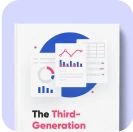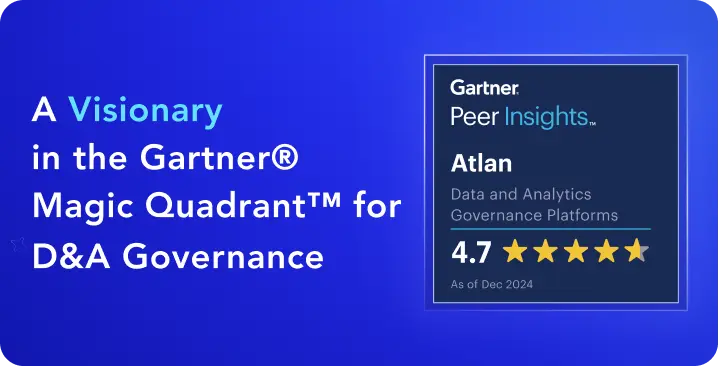Data Lineage in Banking: Tracing Data Flows for Transparency, Trust & Compliance
Share this article
Data lineage in banking traces data flow throughout your data estate, mapping relationships between upstream and downstream dependencies in data pipelines. With effective lineage tracking, banks can ensure data accuracy, improve compliance, and streamline audits while reducing risks associated with poor data quality.
See How Atlan Simplifies Data Governance ✨ – Start Product Tour
In this article, we’ll explore how data lineage contributes to operational efficiency, compliance, and decision-making in the banking sector.
Table of Contents #
- What is data lineage in banking?
- The business benefits of data lineage in banking
- Top challenges of data lineage in banking
- Data lineage in banking: How a metadata control plane can help
- How Atlan’s data lineage empowers banking: Success stories from Austin Capital Bank and Porto
- Wrapping up: Strengthen banking operations with effective data lineage
- Data lineage in banking: Related reads
What is data lineage in banking? #
Data lineage is the process of mapping the lifecycle of data—from origin to consumption—within banking systems. It traces and visualizes data flows across systems, providing a clear understanding of a data asset’s journey throughout its lifecycle.
“Data lineage specifies data origins, shows the movement of data over time and provides context to what happens to data as it goes through diverse systems and processes. Data and analytics leaders must use data lineage to augment their metadata management strategy.” - Gartner on using data lineage to enhance data management capabilities
Also, read → Gartner on data lineage: Trends and recommendations (2025)
Data lineage in banking involves the following:
- Data tracking: Mapping the flow of data from its source to consumption.
- Data transformation: Capturing every change, aggregation, or modification in data.
- Audit trail documentation: Providing a record of data’s lifecycle for regulatory purposes.
- Dependency mapping: Highlighting upstream and downstream dependencies to predict the impact of changes.
The role of data lineage in banking systems #
“End-to-end lineage connects your source systems (databases, SaaS tools, etc.) and maps data flows to your final usage layer, BI tools. Achieve this and you’ll finally know how data flows across your ecosystem — one of the most impactful tools a data team can have for problems like impact analysis, data observability, root cause analysis, and cost optimization.” - Prukalpa Sankar on evaluating data lineage
Modern banking systems are highly complex, with data flowing across core banking platforms, trading systems, payment gateways, risk management tools, and compliance platforms. Additionally, many banks still rely on legacy systems that don’t integrate well with modern data tools, making lineage tracking difficult.
With increasing regulatory scrutiny, banks must ensure full data traceability to facilitate audits, maintain compliance, and quickly investigate discrepancies. Effective data lineage tackles these issues by enabling real-time impact analysis, streamlining compliance, and ensuring data-driven decision-making.
Top use cases of data lineage in banking #
“Most banks are working hard to extract some business value from data lineage; for example, by using it as a basis to simplify their data architecture or to spot unauthorized data-access points, or even to identify inconsistencies among data in different reports.” - McKinsey on optimizing data controls in banking
Data lineage plays a crucial role in ensuring data integrity, transparency, and compliance within banking systems. From troubleshooting errors to managing risks, it provides visibility into how data moves, transforms, and impacts critical banking operations.
Some of the use cases of data lineage in banking include:
- Root cause analysis: Data lineage helps banks identify discrepancies or errors in financial reports by tracing data back to its source. For instance, if you notice a discrepancy in one of your dashboards, you can track whether the issue originated from incorrect transactional data, transformation errors, or misconfigured ETL pipelines.
- Impact analysis: When banks implement system upgrades or modify data models, data lineage helps assess the downstream impact of these changes. For example, if an ETL job that processes daily transaction data is modified to include new fields, lineage mapping ensures that dependent reports, fraud detection models, and regulatory filings continue functioning correctly. This prevents broken dashboards, incorrect risk assessments, and compliance issues.
- Risk management: By providing full visibility into data movement and dependencies, data lineage helps banks mitigate operational risks. Most banking systems use multiple data sources—transactions, customer profiles, and external fraud databases. If data lineage reveals an interruption in one of these sources, you can proactively address gaps quickly.
- Regulatory compliance: Regulators require banks to demonstrate how they process, store, and report financial data. Data lineage can help in supporting compliance with regulations like BCBS 239, GDPR, and SOX by documenting end-to-end data flows and transformations.
The business benefits of data lineage in banking #
Data lineage in banking provides banks with greater visibility into their data flows, enabling better decision-making, operational efficiency, and cost optimization, among others.
Let’s look at the top business benefits of data lineage in banking:
- Faster root-cause analysis and issue resolution: Data lineage allows banks to quickly trace errors back to their source, reducing downtime and minimizing the impact of data discrepancies on critical operations.
- Operational efficiency through improved data quality and governance: By mapping data movement and transformations, banks can identify inconsistencies, enforce data governance policies, and enhance overall data reliability. For example, by visualizing data dependencies across systems, banks can proactively identify potential bottlenecks or inconsistencies. This optimizes your workflows, minimizes inefficiencies, and enables faster time-to-insight.
- Enhanced compliance with data security and privacy regulations: According to Gartner, data lineage supports security and privacy because it helps to identify data as it evolves across structured and unstructured formats and locations. With clear data lineage, banks can demonstrate compliance with regulations by providing auditable records of data handling and transformations. For example, data lineage ensures that PII is tracked and protected throughout its lifecycle.
- Simplified audit and reporting processes: Banks can streamline regulatory reporting by automatically generating data flow visualization and audit trails, reducing manual effort, and ensuring transparency in financial data processing.
- Cost savings through efficiency and automation: Automated data lineage reduces the need for manual data tracing, minimizing operational risks and lowering costs associated with regulatory fines, inefficiencies, and data errors.
Top challenges of data lineage in banking #
Implementing data lineage in the banking sector involves navigating numerous complexities due to the industry’s vast and interconnected systems. Below are some of the major challenges banks face with data lineage mapping:
- Complex, interconnected system landscapes: Banks operate across multiple platforms, from core banking systems to third-party financial applications, making it challenging to track data lineage across diverse environments, especially if done manually.
- Data volume and variety challenges: Banks generate massive amounts of structured and unstructured data across transactions, risk assessments, and customer interactions, making real-time lineage tracking complex and resource-intensive.
- Legacy system integration barriers: Many banks still rely on decades-old legacy systems that lack built-in support for modern data lineage tracking, requiring custom solutions or middleware for integration.
- Regulatory compliance complexity: Banks must comply with evolving regulations and account for advances in technology (generative AI, for instance). This requires comprehensive data lineage tracking to demonstrate data accuracy, security, and auditability.
Data lineage in banking: How a metadata control plane can help #
While data lineage enhances visibility, managing it at scale across thousands of assets and systems requires a centralized metadata control plane.
“Data producers can’t manually inform every business user when a pipeline fails or a model has been updated, yet data consumers need to stay informed and aware of any upstream changes. The solution? A metadata automation layer that propagates trust signals, such as alerts and notifications, from source to destination.” - Prukalpa Sankar on the role of a metadata control plane in automating end-to-end lineage
A metadata control plane provides a centralized approach to managing, tracking, and governing data lineage in banking. By integrating metadata across diverse systems, it ensures consistency, transparency, and compliance while reducing operational inefficiencies.
Here’s how a metadata control plane can help improve data lineage in banking:
- Centralized visibility and governance: A metadata control plane unifies data lineage across multiple banking systems, including core banking platforms, ETL pipelines, and cloud-based analytics. This eliminates silos and provides a single pane of glass for data movement and transformation.
- Automated, cross-system, granular lineage tracking: A metadata control plane automates lineage capture across structured and unstructured data sources. This enables real-time tracking of data origin, transformation, and downstream impact, improving accuracy and efficiency.
- Granular impact analysis: A metadata control plane offers data lineage that supports impact analysis, identifying the impact of a change on any metadata element. It’s deep enough to allow for drilling down or analyzing to the finest level of detail, such as column-level or transformation logic.
- Seamless integration with legacy and modern systems: Banks often operate on a mix of legacy and modern data architectures. A metadata control plane integrates with both, enabling consistent lineage tracking across databases, data lakes, and third-party platforms without disrupting existing workflows. It’s also designed to be open by default, making it possible to extend your data ecosystem to connect the various tools, platforms, and applications in your data stack.
- Scalability and automation: A metadata control plane supports large-scale banking environments by automating metadata collection, lineage mapping, and governance processes. This reduces manual effort, lowers operational costs, and ensures that data lineage scales as banking systems grow.
Also, read → Why a metadata control plane is the missing bridge to the data trust gap
Data lineage in banking: Questions to ask when evaluating solutions #
Mark Pavletich and Swami Kumar from Atlan reviewed cases of data use from hundreds of data teams to put together the following questions that anybody evaluating data lineage should know:
- Which types of SQL statements are supported? Look for lineage tools with automated SQL parsing.
- Does it offer lineage down to the column level? Look for a native column-level experience in the UI, including viewing graph linkages at the column level.
- Does it support field-level lineage for BI dashboards? Check which BI objects are supported and exposed for your BI tool.
- Does it incorporate other types of metadata to give additional context for assets in the lineage graph? Look for openness by design, flexibility, and personalized data experiences.
- Can it be used not just to investigate issues, but also to drive action programmatically? Look for open APIs, the ability to build or customize automated workflows, and the ability to read metadata-change events and trigger changes in linked assets across the lineage graph.
Read more → The ultimate guide to evaluating data lineage
How Atlan’s data lineage empowers banking: Success stories from Austin Capital Bank and Porto #
Atlan’s data lineage capabilities are helping financial institutions optimize data management, streamline operations, and make informed decisions. Here’s how Austin Capital Bank and Porto are leveraging Atlan to solve their data challenges.
Austin Capital Bank: Enhancing Data Visibility and Decision-Making #
Use Cases:
-
Tracking Data Flow: Austin Capital Bank leverages Atlan to visualize the entire data journey, ensuring transparency and control over their data lifecycle.
-
Assessing Impact of Changes: Atlan helps the bank analyze the downstream effects of any data model changes, minimizing risks of disruptions.
“We can make changes and understand where the impact would be so that nothing breaks.” — Ian Bass, Head of Data & Analytics
-
Data Organization and Glossary Integration: Atlan’s lineage enables seamless management of data assets and glossary terms, improving data clarity and communication.
“The fact that we have data lineage and the ability to organize information and add glossary terms? That’s all icing on the cake for us.” — Ian Bass
Porto: Boosting Data Literacy and Cutting Costs #
Use Cases:
-
Mapping Data Flow: Porto uses Atlan’s automated lineage to map how data moves across their systems, enabling their teams to find relevant data faster and with better context.
-
Improving Data Literacy: By extending lineage to BI tools like Tableau and PowerBI, Porto enhances data literacy across the organization, empowering teams to make data-driven decisions.
“We’ll capture lineage from the source to the dashboard used for executive reporting.” — Danrlei Alves, Senior Data Governance Analyst.
-
Cost Optimization: Atlan’s lineage helps Porto identify unused data assets, leading to significant cost savings by deprecating unneeded pipelines and databases.
Atlan’s data lineage is helping banks like Austin Capital Bank and Porto enhance visibility, streamline processes, and reduce costs, making data management more efficient and transparent. Book a demo today and see how data lineage can empower your organization.
Wrapping up: Strengthen banking operations with effective data lineage #
Data lineage in banking is a critical component of modern data management, enabling transparency, operational efficiency, and compliance. By addressing challenges such as legacy systems and data silos with advanced tools, banks can unlock the full potential of their data.
Investing in a metadata control plane like Atlan ensures better data quality, governance, compliance, and improved decision-making.
Data lineage in banking: Related reads #
- Data Compliance Management in Banking: Your Complete Guide in 2025
- Data Governance in Banking: Benefits, Challenges, Capabilities
- Data Discovery in Banking: Get Business Value from Siloed Data
- Unified Control Plane for Data: The Future of Data Cataloging
- What is Data Governance? How Atlan Views and Implements It
- Data Governance and Compliance: An Act of Checks & Balances
- Data Compliance Management in 2025
- How enterprise data catalogs drive business value
- Data Governance and GDPR: A Comprehensive Guide to Achieving Regulatory Compliance
- BCBS 239 Compliance: What Banks Need to Know in 2025
- FRTB Compliance: Exploring the 6 Core Pillars, Benefits, Impact
- IFRS 17 Compliance: Requirements, Benefits & More
- Data Governance & Business Intelligence: Why Their Integration Matters and How It is Crucial for Business Success?
- What is Data Discovery: Definition, Purpose, Process, Techniques, Tools
- What are Data Silos and How Can You Break Them Down?
- Data Migration in Banking: Your Complete 2025 Guide
Share this article











